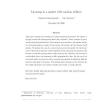Free Online Productivity Tools
i2Speak
i2Symbol
i2OCR
iTex2Img
iWeb2Print
iWeb2Shot
i2Type
iPdf2Split
iPdf2Merge
i2Bopomofo
i2Arabic
i2Style
i2Image
i2PDF
iLatex2Rtf
Sci2ools
MSS
2008
IEEE
2008
IEEE
Licensing of a quality-improving innovation
This paper considers the licensing of a quality-improving innovation. We analyze a duopoly model with heterogeneous firms and consumers. Firms compete in prices and face logit demand functions. The innovator is an outsider to the market and his set of licensing policies consists of the auction, the royalty and the two-part tariff policies. We analyze the cases of a covered and an uncovered market. For the former case we show that irrespective of the magnitude of the innovation the innovator sells licenses to both firms using positive royalty and zero fee. Moreover, the increase in social welfare due to the innovation is fully appropriated by him. For the case of an uncovered market we show that when consumer heterogeneity is sufficiently high the innovator sells again two licenses. The optimal policy depends on the valuation for the outside alternative and consists of either only royalty or royalty plus fee.
| Added | 13 Dec 2010 |
| Updated | 13 Dec 2010 |
| Type | Journal |
| Year | 2008 |
| Where | MSS |
| Authors | Giorgos Stamatopoulos, Yair Tauman |
Comments (0)

